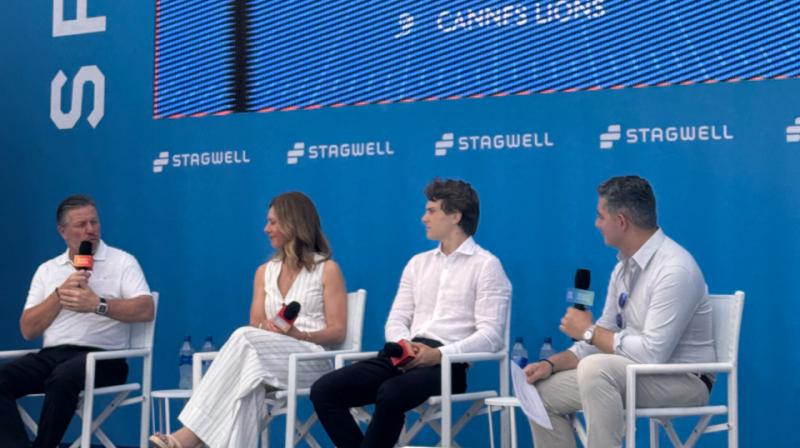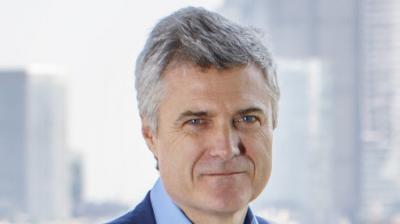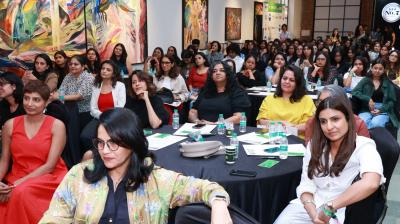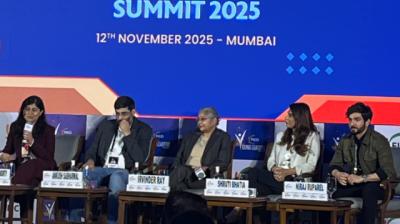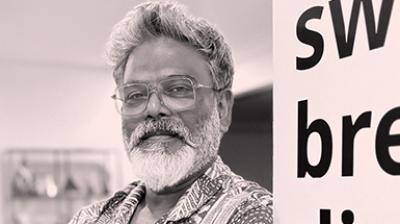Oscar Piastri, F1 driver, team Mclaren; Louise McEwen, chief marketing officer, McLaren Racing; and Zak Brown, CEO, McLaren Racing, took to Stagwell’s ‘Sport Beach’ on day four of the Cannes Lions International Festival of Creativity to discuss how they have built a ‘long-standing brand with the world’s fastest’ sport. The panel was moderated by Karim Rayes, chief product officer, Nexxen.
Rayes stated how F1 is looking to reshape how fans are engaging with the sport.
He stated that there are 827 million fans who are following the sport globally, with one of three being new to the sport.
“Viewership was linear on TV, now there’s on-demand starting thanks to streaming shows like Netflix’s Drive to Survive and a new film on the sport also in the offing,” said Rayes, before introducing the Piastri, who is currently leading the driver’s championship in F1.
Talking about how he has grown as a personality and how engagement with fans has changed over the last year and a half, Piastri said, “A few more people know who I am now. I’m getting used to this life right now. When I first joined F1 and McLaren, we were the team that everyone wanted to do well, but we weren’t. Last year, we won a few races and won the constructor’s championship. People have started supporting us. The support I’ve had through my career and this season has been special.”
McEwen stated how marketing has changed for McLaren with the new way of engagement.
“We are lucky to have two superstar drivers. They are dreamy to work with and resonate with fans. In 2023, Oscar appeared on the scene relatively unknown. Performance helps and so does the driver’s personality. The Netflix documentary has also helped humanise the brand,” she said.
Brown discussed how F1’s growth is outpacing other sports.
“We have learned a lot from other sports. Our sport is on fire because of that. And growth won’t stop anytime soon. We are a global sport and our appeal is very broad. We have more demand than supply right now as more countries want to host races, and more media rights owners want to get a piece of the pie as well,” he said.
Talking about McLaren’s associations, he stated, “The brand roster is also the best across all sports for us at McLaren. We have to start with Liberty Media (they acquired the sport in 2016) which has helped create a massive fan base. Historically, the sport didn’t do that. The Netflix series helped, for sure.”
He added, “We needed more viewers. We needed viewers from North America, youngsters and women. Now, we have that, and brands have followed. The sport is in a great place and we need to keep engaging with the fans.”
Data
While all sports are gravitating to the use of data and technology, F1 has always used them, given how milliseconds could make a difference.
Even with more technology available, Paistri stated that one cannot rely on it solely.
“We get to drive on the circuit only on the race weekend. The race track isn’t available to use otherwise. Simulators are there, but sometimes they are a different thing altogether. We reach the track and always compare notes with each other,” he said.
Brown also spoke about the importance of human creativity within this data-driven world.
“Nothing beats data. But you need to combine data, AI, and the human. That’s what plays out the perfect race. Data can’t give all the answers. Louise loves using data on the marketing side. One can customise our marketing thanks to it. People like the sport because of the drivers, team or technology. But we can customise in a way to serve F1 to the fans, in a way that matches their interest,” he said.
Adding to Brown’s take on marketing, McEwen, said, “With all the new fans coming to the sport we have an opportunity to reach out to them. Just like we put a car out on track which has been tested a zillion times, we check that with our campaigns too. We always want to make the next campaign better than the previous one. We celebrate it. Our fan base has two kinds of people - who have supported us for 60 years and watch linear TV for 90 minutes every Sunday. And then the new ones.”
Piastri was asked how he balances his brand efforts for the team and himself.
He said, “When I joined F1, I did more work off the track than on it. It’s a learning process and a fine balance between hard work on the track and off it. We have to make it as efficient as possible for myself and Lando (Norris). The team makes our journey as fun as possible, but we want to focus on driving the car as fast as we can. We still want to get value for the brands.”
McEwen stated how winning the constructors championship last year changed things for McLaren racing.
“It’s an incredible place to be. But it took us 26 years to get back that title. It took a lot of grit and hard work. We had to build resilience. The trophy cabinet is expanding and we need to create storytelling and resilience. Even if we aren’t winning trophies we need to stay connected with the fans. It takes a lot of time, energy and talent,” she said.
Brown spoke about how sponsorship of the sport has evolved.
“Sponsors have come a long way from having that logo on the race car to now looking at ways of integrating with us. They all make contributions to the team and we can’t go racing without them. Our B2B or technology partners are integrated within the team. They enjoy working with McLaren because we give them challenges. We go to them with issues and they sort it out for us. Our consumer brands help us engage with the fans and bring in new fans since they’re talking to many consumers daily. The drivers are the superstars of our sport, but so are our engineers and technologies. We have done TV spots with HR, the finance department and engineers. Corporate partnerships are all about storytelling.
What’s next?
In 2026, regulations of the sport are to change, which means the configurations of the cars will have to change.
How will McLaren tackle that?
Calling it tricky, Brown said, “Some teams don’t have a chance this year (to win the championship) and are working on 2026 already. But we are in contention. Every dollar we spend on this year’s car is not what we’re spending on it next year. The car from this season has no carry-over to next year. That’s exciting and terrifying at the same time because no one has any reference points. But McLaren has proven we have a lot of smart men and women and have the resources, so we should put a fast car on the racing track.”
Giving the marketing perspective, McEwen, stated, “We are already working on 2026 and beyond. We can’t stand still. It’s just as competitive off-track as it is on it. Within the marketing world, I’m not constrained by the cost cap.”
She added, “Only 1% of the huge fan base gets to go on track (to watch a race) in their lifetime. We want to take that opportunity to reach out and have deeper fan connections and that’s where social helps.”
She concluded the talk by stating how the brand is looking to deliver content in real-time.
“Our real-time technologies are important so that one can make sure the content is being delivered in real-time. Some of our circuits like Spa (Belgium) attract the hardcore F1 fan. Then, there are the likes of Las Vegas which brings in more of the entertainment. There’s something for everyone and we can play on that and make the most of it,” said McEwen.

